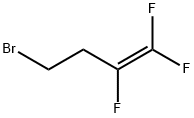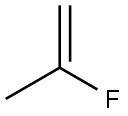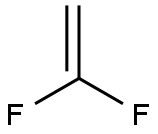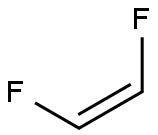4-Bromo-1,1,2-trifluoro-1-butene
- CAS NO.:10493-44-4
- Empirical Formula: C4H4BrF3
- Molecular Weight: 188.97
- MDL number: MFCD00039274
- EINECS: 234-019-2
- SAFETY DATA SHEET (SDS)
- Update Date: 2023-10-23 11:10:09

What is 4-Bromo-1,1,2-trifluoro-1-butene?
Chemical properties
clear colorless to brown-yellow liquid
The Uses of 4-Bromo-1,1,2-trifluoro-1-butene
4-Bromo-1,1,2-trifluoro-1-butene is used in organic synthesis, chemical research and pharmaceuticals.
The Uses of 4-Bromo-1,1,2-trifluoro-1-butene
4-Bromo-1,1,2-trifluoro-1-butene may be used in the preparation of 1,1,2-trifluoro-1-butene, via reaction with KOH in the presence of phase-transfer catalyst, tetrabutylammonium bromide.
General Description
4-Bromo-1,1,2-trifluoro-1-butene is a fluorinated building block. It reacts with potassium hydroxide in the presence of tetrabutylammonium bromide (a phase transfer catalyst) to afford 1,1,2-trifluoro-1,3-butadiene.
Properties of 4-Bromo-1,1,2-trifluoro-1-butene
| Boiling point: | 95-98 °C (lit.) |
| Density | 1.639 g/mL at 25 °C (lit.) |
| refractive index | n |
| Flash point: | 63 °F |
| storage temp. | Flammables area |
| form | liquid |
| color | Clear, faint lime |
| Water Solubility | Not miscible or difficult to mix in water. |
| Sensitive | Light Sensitive |
| BRN | 1840755 |
| InChI | InChI=1S/C4H4BrF3/c5-2-1-3(6)4(7)8/h1-2H2 |
| CAS DataBase Reference | 10493-44-4(CAS DataBase Reference) |
| NIST Chemistry Reference | 4-Bromo-1,1,2-trifluorobutene-1(10493-44-4) |
Safety information for 4-Bromo-1,1,2-trifluoro-1-butene
| Signal word | Danger |
| Pictogram(s) |
 Flame Flammables GHS02  Exclamation Mark Irritant GHS07 |
| GHS Hazard Statements |
H225:Flammable liquids H319:Serious eye damage/eye irritation H335:Specific target organ toxicity, single exposure;Respiratory tract irritation |
| Precautionary Statement Codes |
P210:Keep away from heat/sparks/open flames/hot surfaces. — No smoking. P280:Wear protective gloves/protective clothing/eye protection/face protection. P301+P312:IF SWALLOWED: call a POISON CENTER or doctor/physician IF you feel unwell. P303+P361+P353:IF ON SKIN (or hair): Remove/Take off Immediately all contaminated clothing. Rinse SKIN with water/shower. P305+P351+P338:IF IN EYES: Rinse cautiously with water for several minutes. Remove contact lenses, if present and easy to do. Continuerinsing. |
Computed Descriptors for 4-Bromo-1,1,2-trifluoro-1-butene
| InChIKey | GQCQMFYIFUDARF-UHFFFAOYSA-N |
| SMILES | C(/F)(\F)=C(/F)\CCBr |
New Products
4-Fluorophenylacetic acid 4-Methylphenylacetic acid N-Boc-D-alaninol N-BOC-D/L-ALANINOL Tert-butyl bis(2-chloroethyl)carbamate 3-Morpholino-1-(4-nitrophenyl)-5,6-dihydropyridin- 2(1H)-one Furan-2,5-Dicarboxylic Acid Tropic acid S-2-CHLORO PROPIONIC ACID ETHYL ISOCYANOACETATE 2-Bromo-1,3-Bis(Dimethylamino)Trimethinium Hexafluorophosphate (6-METHYL-[1,3]DITHIOLO[4,5-b]QUINOXALIN-2-ONE INDAZOLE-3-CARBOXYLIC ACID 4-IODO BENZOIC ACID (2-Hydroxyphenyl)acetonitrile 4-Bromopyrazole 5,6-Dimethoxyindanone 2-(Cyanocyclohexyl)acetic acid 4-methoxy-3,5-dinitropyridine 2-aminopropyl benzoate hydrochloride 1-(4-(aminomethyl)benzyl)urea hydrochloride diethyl 2-(2-((tertbutoxycarbonyl)amino) ethyl)malonate tert-butyl 4- (ureidomethyl)benzylcarbamate Ethyl-2-chloro((4-methoxyphenyl)hydrazono)acetateRelated products of tetrahydrofuran








You may like
-
 2033-24-1 98%View Details
2033-24-1 98%View Details
2033-24-1 -
 42831-50-5 5-METHYLISOXAZOLE-4-CARBOXYLIC ACID 98%View Details
42831-50-5 5-METHYLISOXAZOLE-4-CARBOXYLIC ACID 98%View Details
42831-50-5 -
 1975-50-4 98%View Details
1975-50-4 98%View Details
1975-50-4 -
 2-HYDROXY BENZYL ALCOHOL 98%View Details
2-HYDROXY BENZYL ALCOHOL 98%View Details
90-01-7 -
 2-Chloro-1,3-Bis(Dimethylamino)Trimethinium Hexafluorophosphate 221615-75-4 98%View Details
2-Chloro-1,3-Bis(Dimethylamino)Trimethinium Hexafluorophosphate 221615-75-4 98%View Details
221615-75-4 -
 61397-56-6 CIS BROMO BENZOATE 98%View Details
61397-56-6 CIS BROMO BENZOATE 98%View Details
61397-56-6 -
 14714-50-2 (2-Hydroxyphenyl)acetonitrile 98+View Details
14714-50-2 (2-Hydroxyphenyl)acetonitrile 98+View Details
14714-50-2 -
 118753-70-1 98+View Details
118753-70-1 98+View Details
118753-70-1
Statement: All products displayed on this website are only used for non medical purposes such as industrial applications or scientific research, and cannot be used for clinical diagnosis or treatment of humans or animals. They are not medicinal or edible.